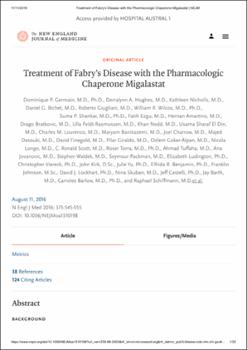| dc.description.abstract | BACKGROUND:
Fabry's disease, an X-linked disorder of lysosomal α-galactosidase deficiency, leads to substrate accumulation in multiple organs. Migalastat, an oral pharmacologic chaperone, stabilizes specific mutant forms of α-galactosidase, increasing enzyme trafficking to lysosomes.
METHODS:
The initial assay of mutant α-galactosidase forms that we used to categorize 67 patients with Fabry's disease for randomization to 6 months of double-blind migalastat or placebo (stage 1), followed by open-label migalastat from 6 to 12 months (stage 2) plus an additional year, had certain limitations. Before unblinding, a new, validated assay showed that 50 of the 67 participants had mutant α-galactosidase forms suitable for targeting by migalastat. The primary end point was the percentage of patients who had a response (≥50% reduction in the number of globotriaosylceramide inclusions per kidney interstitial capillary) at 6 months. We assessed safety along with disease substrates and renal, cardiovascular, and patient-reported outcomes.
RESULTS:
The primary end-point analysis, involving patients with mutant α-galactosidase forms that were suitable or not suitable for migalastat therapy, did not show a significant treatment effect: 13 of 32 patients (41%) who received migalastat and 9 of 32 patients (28%) who received placebo had a response at 6 months (P=0.30). Among patients with suitable mutant α-galactosidase who received migalastat for up to 24 months, the annualized changes from baseline in the estimated glomerular filtration rate (GFR) and measured GFR were -0.30±0.66 and -1.51±1.33 ml per minute per 1.73 m(2) of body-surface area, respectively. The left-ventricular-mass index decreased significantly from baseline (-7.7 g per square meter; 95% confidence interval [CI], -15.4 to -0.01), particularly when left ventricular hypertrophy was present (-18.6 g per square meter; 95% CI, -38.2 to 1.0). The severity of diarrhea, reflux, and indigestion decreased.
CONCLUSIONS:
Among all randomly assigned patients (with mutant α-galactosidase forms that were suitable or not suitable for migalastat therapy), the percentage of patients who had a response at 6 months did not differ significantly between the migalastat group and the placebo group. (Funded by Amicus Therapeutics; ClinicalTrials.gov numbers, NCT00925301 [study AT1001-011] and NCT01458119 [study AT1001-041].). | en_US |


